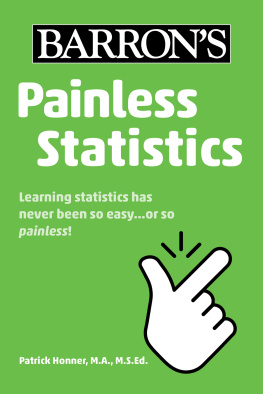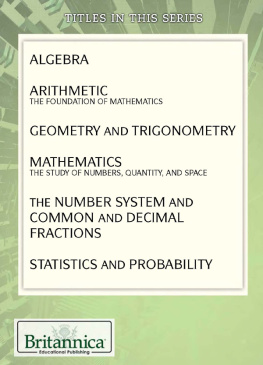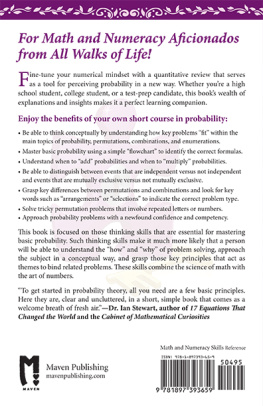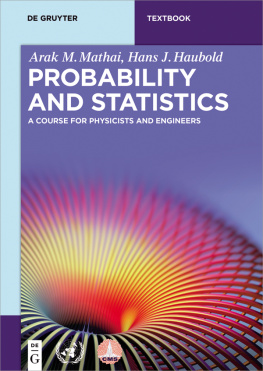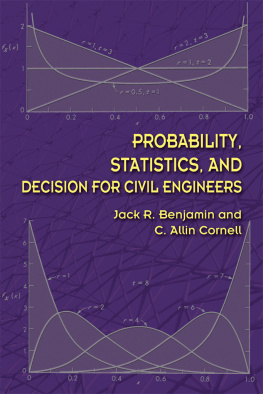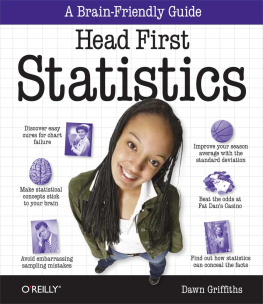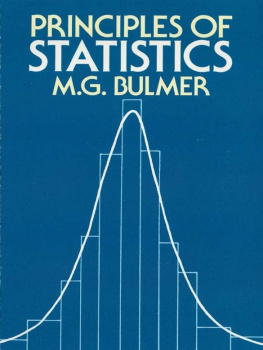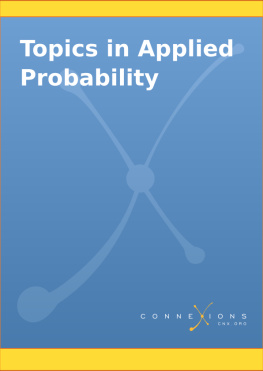STATISTICS AND PROBABILITY

Published in 2015 by Britannica Educational Publishing (a trademark of Encyclopdia Britannica, Inc.) in association with The Rosen Publishing Group, Inc.
29 East 21st Street, New York, NY 10010
Copyright 2015 by Encyclopdia Britannica, Inc. Britannica, Encyclopdia Britannica, and the Thistle logo are registered trademarks of Encyclopdia Britannica, Inc. All rights reserved.
Rosen Publishing materials copyright 2015 The Rosen Publishing Group, Inc. All rights reserved
Distributed exclusively by Rosen Publishing.
To see additional Britannica Educational Publishing titles, go to rosenpublishing.com.
First Edition
Britannica Educational Publishing
J. E. Luebering: Director, Core Reference Group
Anthony L. Green: Editor, Comptons by Britannica
Rosen Publishing
Hope Lourie Kilcoyne: Executive Editor
Jeanne Nagle: Editor
Nelson S: Art Director
Nicole Russo: Designer
Cindy Reiman: Photography Manager
Introduction by John Strazzabosco.
Library of Congress Cataloging-in-Publication Data
Statistics and probability/edited by Elisa Peters.First edition.
pages cm.(The story of math : core principles of mathematics)
Audience: Grades 7 to 12.
Includes bibliographical references and index.
ISBN 978-1-6227-5534-9 (eBook)
1. Mathematical statisticsJuvenile literature. 2. ProbabilitiesJuvenile literature. I. Peters, Elisa, editor.
QA276.13.S73 2015
519.5dc23
2014030489
Cover and interior pages agsandrew/Shutterstock.com; cover (top), back cover, p. 3 (top) Indivision 07 Grow B/Getty Images.
Contents
S tatistics and probability are two of the most useful branches of math. Statistics is the gathering, analysis, interpretation, and presentation of numerical data. Probability is the mathematical study of the chances events have of occurring. Both probability and statistics have many real-world applications. While math discoveries are fascinating in themselves, when they lead to wonderful inventions that we humans actually use, then we see why people study these ideas in the first place. For example, a major league baseball team suddenly began winning games as they never had before when they hired a statistician to find out what really was important in a game. They had found that following the same old ideas was resulting in disaster.
But perhaps even more inspiring was a recent development in the world of youth basketball that provides a glimpse into the power of statistics. A dad recently began to coach his daughters basketball team, and strangely no one on his team could dribble or shoot the ball very well. Neither could he, for that matter. Yet they won a state championship! How? The dad studied basketball statistics and discovered a high correlation between team defense and team success. So he focused purely on defense. His girls scored baskets only when they stole the ball and got an easy layup. The opponents found themselves confused, frustrated, and losing to this unusual approach.

Professional baseball is a sport in which statistics plays a particularly big role. Professional statisticians work with teams, while fans can often recite their favorite players stats. Boston Globe/Getty Images
The world of probability also has fascinating uses, beyond what one might imagine. Sometimes we want to do something but have no clue about whether its even possible. Probability can provide clues, even to whether a situation will likely turn dangerous. For instance, when the very first astronauts were sent into space, nobody had ever done that before. One astronaut later reported that he wondered if he might get fried by light energy if he strayed outside the spaceship during a space walk. So scientists had to figure out things like what to expect from light rays and even meteorites that might shoot by out of nowhere, or many other random dangers that might occur. They were forced to have mathematicians figure out the probabilities that random problems might occur, so they might be avoided. And it worked! Our space program was successful. More important, space accidents were reduced.
A nyone who watches television, browses the Internet, or reads books, newspapers, and magazines cannot help but be aware of statistics. The term statistics is used in two different ways. When used in the plural, it refers to numerical data. For example, one would say, Statistics show highway accidents to be caused by... When used in the singular, it means statistical methods, as in Statistics is the body of principles and methods that has been developed for collecting, analyzing, presenting, and interpreting large masses of numerical data. Without statistical methods, there would be no way to put data together to see what they mean.
Statistics appear in the claims of advertisers, in predictions of election results and opinion polls, in cost-of-living indexes, and in reports of business trends and cycles. Every science depends to some extent upon the gathering of data and the interpreting of the data by statistical methods. On the basis of statistics, important decisions are made in the fields of government, industry, and education. Even the average person bases many personal decisions on information that has been supplied by statisticians.

Pie charts, like the one this businessman is using, are one common way to display statistics. AP Images
The results of statistical investigations may sometimes be stated in a single sentence, as in weather forecasting. Often, however, they are presented in the form of numerical tables or are shown pictorially in the form of graphs or charts.
HOW STATISTICAL DATA ARE COLLECTED
Statistical data are usually collected in one of the following ways: (1) by consulting existing source material, such as periodicals and newspapers, or reports from industries, government agencies, and research bureaus; (2) by setting up a survey and collecting data firsthand from individuals or organizations; and (3) by conducting scientific experiments and measuring or counting under controlled conditions.
Basic information must be collected in such a way that it is accurate, representative, and as comprehensive as possible. Statistical treatment cannot in any way improve the basic validity or accuracy of the raw data. Methods of collecting data are therefore basic to the whole field of statistics.
POPULATIONS
The term population ordinarily means the whole number of people in a specific place. The statistician speaks of a population of automobiles, salaries, accidents, ballots, blood pressures, or any other characteristic. For the statistician a populationalso called a universemeans the entire group of items in the class being considered.
Usually it is not possible to gather observations from all the possible cases in a population. Some populations are infinite. For example, if you should want to count how many times heads will turn up when a penny is tossed, you would have to set a limit to the number of throws because even a billion would not exhaust the infinite universe of possible trials.
THE LAW OF LARGE NUMBERS








